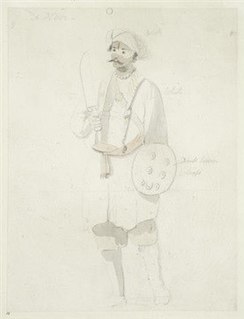Related Research Articles

Kshatriya is one of the four varna of Hindu society, associated with warrior aristocracy. The Sanskrit term kṣatriyaḥ is used in the context of Vedic society wherein members were organised into four classes: brahmin, kshatriya, vaishya and shudra.
Shudra or Shoodra is the lowest ranked of the four varnas of the Hindu caste system and social order in India. Various sources translate it into English as a caste, or alternatively as a social class.
The island of Bali has a system of social organization similar to the Indian caste system.
Varṇa, in the context of Hinduism, refers to the Brahminic ideology of hierarchizing society into classes. The ideology is epitomized in texts like Manusmriti, which classify the society into four varnas:

The Nair, also known as Nayar, are a group of Indian Hindu castes, described by anthropologist Kathleen Gough as "not a unitary group but a named category of castes". The Nair include several castes and many subdivisions, not all of whom historically bore the name 'Nair'. These people lived, and continue to live, in the area which is now the Indian state of Kerala. Their internal caste behaviours and systems are markedly different between the people in the northern and southern sections of the area, although there is not very much reliable information on those inhabiting the north.
Reddy is a caste that originated in India, predominantly settled in Andhra Pradesh and Telangana. They are classified as a forward caste.
The Maratha clan system refers to the network of 96 clans of families and essentially their surnames, within the Maratha caste of India. The Marathas primarily reside in the Indian state of Maharashtra, with smaller regional populations in other states.

Patidar is an Indian landlord and agrarian caste found mostly in Gujarat but also in at least 22 other states of India. The community comprises at least three subcastes—the Anjanas, Kadavas and Levas They form one of the dominant castes in Gujarat. The process leading to its recognition is a paradigmatic example of the invention of tradition by social groups in India. The Patidars originated from Gujarati Kunbis who reinvented their identity during the British Raj.
Who Were the Shudras? is a history book published by Indian social reformer and polymath B. R. Ambedkar in 1946. The book discusses the origin of the Shudra Varna. Ambedkar dedicated the book to Jyotirao Phule (1827–1890).
The caste system in Kerala differed from that found in the rest of India. While the Indian caste system generally modeled the four-fold division of society into Brahmins, Kshatriyas, Vaishyas and Shudras, in Kerala, the Nambudiri Brahmins formed the priestly class and only rarely recognized anyone else as being other than Shudra or untouchables, the latter being outside the caste system entirely. Thus, the Kerala caste system was ritualized but it was not the varna model found elsewhere. In Southern India, only in Kerala did there appear warrior lineages approximate to the Kshatriya model.These warriors never lost their identity as sudras.
Dvija means "twice-born" in ancient Indian Sanskrit. The concept is premised on the belief that a person is first born physically and at a later date is born for a second time spiritually, usually when he undergoes the ritual of passage that initiates him into a school for Vedic studies. The term also refers to members of the three varnas in the traditional Hindu social system, or social classes — the Brahmins, Kshatriyas (warriors), and Vaishyas — whose Sanskara of Upanayana initiation was regarded as a second or spiritual birth.
This article is about the Caste System in Goa, and describes the various Jātis or sub-castes to be found among Hindus belonging to the four varnas, as well as those outside of them. The traditional Hindu caste system was also retained by the Goan Catholic community, and as such, their castes are mentioned here in this article.

Newar caste system is the system by which Newārs, the historical inhabitants of Kathmandu Valley, are divided into groups on the basis of Vedic varna model and divided according to their hereditary occupations. First introduced at the time of the Licchavis, the Newar caste system assumed its present shape during the medieval Malla period. The Newar caste structure resembles more closely to North India and Madheshis than that of the Khas 'Parbatiyas' in that all four Varna and untouchables are represented. The social structure of Newars is unique as it is the last remaining example of a pre-Islamic North Indic civilisation in which Buddhist elements enjoy equal status with the Brahmanic elements.

Castes are rigid social groups characterized by hereditary transmission of life style, occupation and social status. Caste system in India has its origins in ancient India, and was transformed by various ruling elites in medieval, early-modern, and modern India, especially the Mughal Empire and the British Raj. The caste system consists of two different concepts, varna and jati, which may be regarded as different levels of analysis.
The Rashtrakuta empire of Manyakheta was a notable Deccan empire that ruled most of the modern-day region of south and central India between the 8th to the 10th centuries. Their regal capital was Manyakheta in Gulbarga district, Karnataka state, India. The Rashtrakuta society in many ways reflected the emerging religious, political and cultural developments of those times.
Baidya or Vaidya is a Hindu community of Bengal. A caste/jāti of Ayurvedic physicians, Baidyas have long occupied a place of pre-eminence in society alongside Brahmins and Kayasthas. In the colonial era, the Bhadraloks were drawn from these three castes, who continue to maintain a collective hegemony in West Bengal.
Daṇḍa is the Hindu term for punishment. In ancient India, punishments were generally sanctioned by the ruler, but other legal officials could also play a part. The punishments that were handed out were in response to criminal activity. In the Hindu law tradition, there is a counterpart to daṇḍa which is prāyaścitta, or atonement. Where as daṇḍa is sanctioned primarily by the king, prāyaścitta is taken up by a person upon his or her own volition. Furthermore, daṇḍa provides a way for an offender to right any violations of dharma that he or she may have committed. In essence, daṇḍa functions as the ruler's tool to protect the system of life stages and castes. Daṇḍa makes up a part of vyavahāra, or legal procedure, which was also a responsibility afforded to the king.
Paishacha marriage has been defined in Manu Smriti in section IV - Eight types of marriage
Asura marriage has been defined in Manu Smriti in section IV - Eight types of marriage
Anuloma is a Sanskrit term that is used in the Manusmriti, that is the Laws of Manu, to describe a hypergamous union between a high born man and a woman of a lower standing relative to the respective man. Manu explains that the evolution of different castes among mankind occurred due to the union of two persons who did not belong to the same rung in the caste or class ladder relative to each other. According to Manu, marriage within the same caste, that is, between two persons who belong to the same rung in the ladder, is excellent. Anuloma marriages are considered as "going with the grain" unions. As per Hindu scriptures, Anuloma marriages or unions are not advocated but were tolerated and accepted historically.
References
- 1 2 Subodh Kapoor. The Indian Encyclopaedia: Mahi-Mewat. Genesis Publishing Pvt Ltd, 2002. p. 4642.
- 1 2 Joseph Kitagawa. The Religious Traditions of Asia: Religion, History, and Culture. Routledge, 2013. p. 16.
- ↑ Rajendra Kumar Sharma. Fundamentals of Sociology. Atlantic Publishers & Dist, 1996. p. 253.
- 1 2 Jack Goody. The Character of Kinship. Cambridge University Press, 1975. p. 203.
- 1 2 Jack Goody. The Character of Kinship. Cambridge University Press, 1975. p. 194.
- ↑ Irfan Habib, K. N. Panikkar, T. J. Byres, Utsa Patnaik. The Making of History: Essays Presented to Irfan Habib. Anthem Press, 2002. p. 183.CS1 maint: multiple names: authors list (link)
- ↑ Reddy. Indian Hist (Opt). Tata McGraw-Hill Education, 2006. p. A234.
- ↑ Hajira Kumar. Women's Empowerment, Issues, Challenges, and Strategies: A Source Book. Regency Publications, 2005. p. 27.